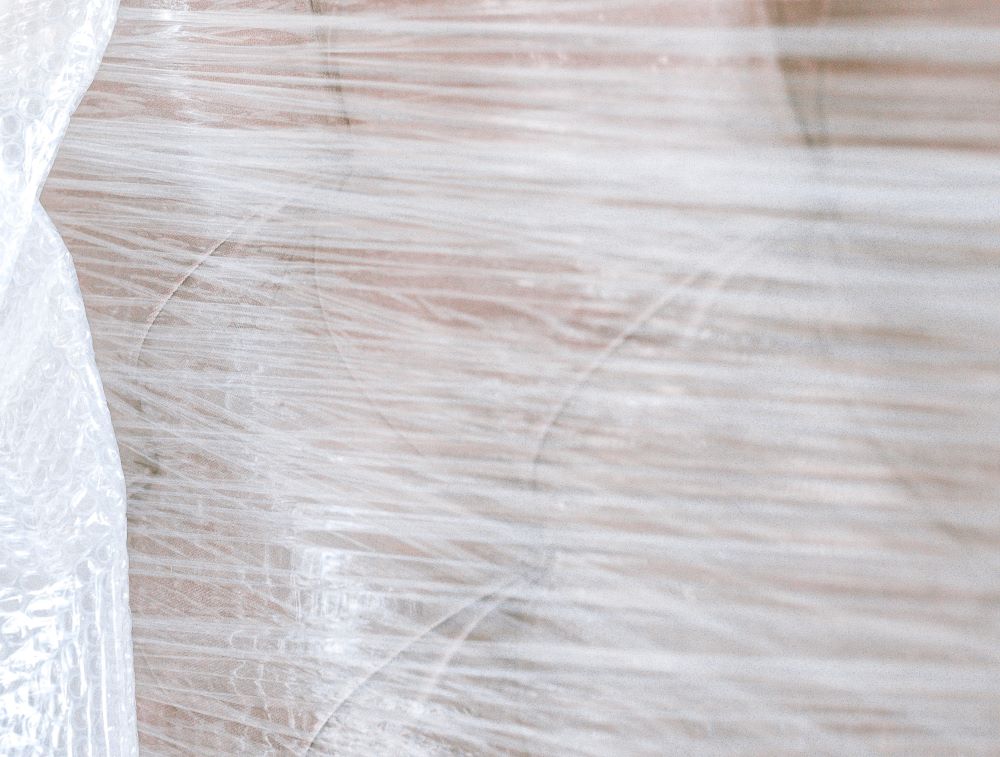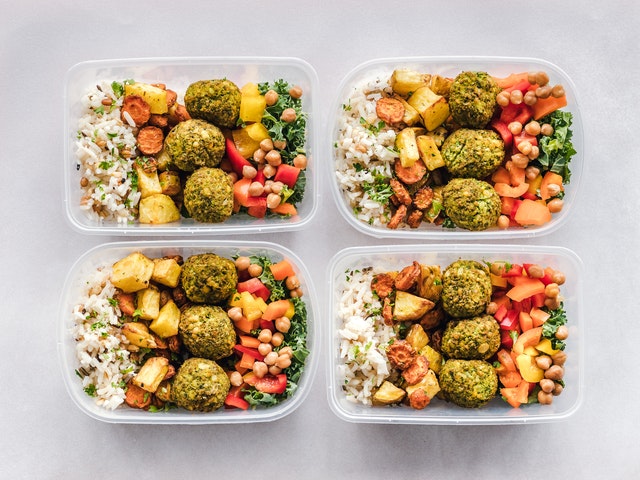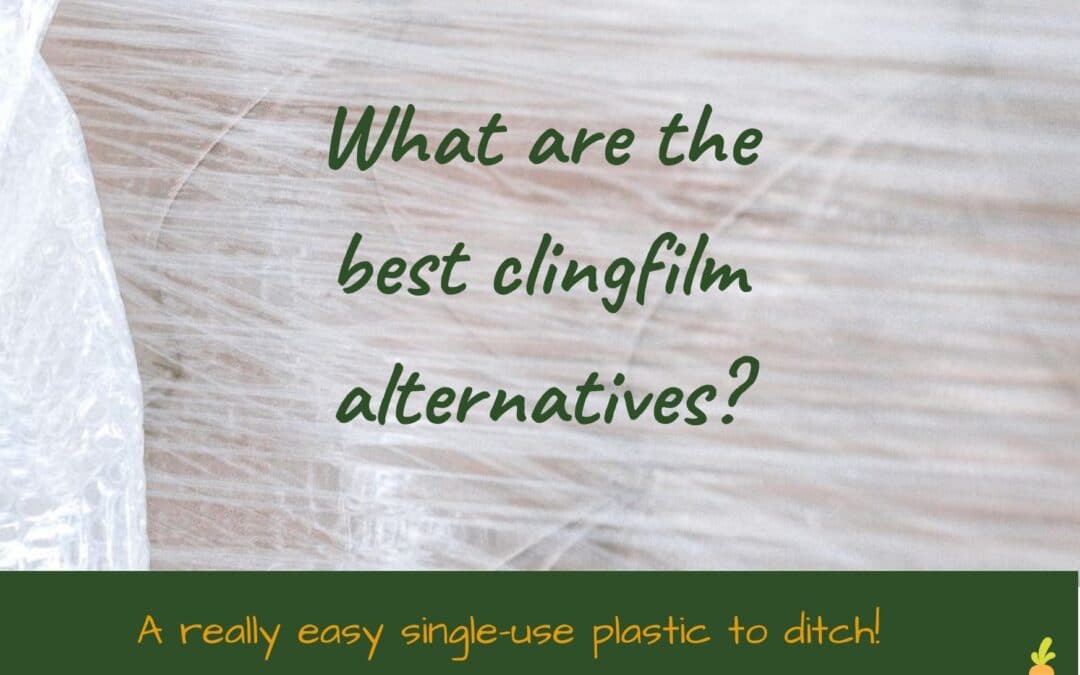This article contains some affiliate links, so if you click on them and buy through my link I'll get a couple of pennies to fund my research time. The price to you doesn't change, and I make my decision before finding the link, so it's unbiased.
What are the best clingfilm alternatives?
When clingfilm came out it was like a wonder product as it could be used for so many things! At the time it seemed to help as it really reduces food waste!
Unfortunately, it’s pretty hard to reuse. In theory you can wash it, but that really is a fiddly job, and the clingfilm often tears, rendering it unusable.
Now that we’ve realised that using something like this once and throwing it away has pretty major repercussions on the environment, it’s time to see what clingfilm alterantives are out there. After all, more than 1.2 billion metres, equating to 745,000 miles of cling film is used by households across Britain every year – enough to go around the circumference of the world 30 times over! That’s a lot of plastic avoided if we can use something else instead!
The issue with clingfilm
Just to be really clear, the issues with clingfilm are:
- It’s made of plastic, or PVC (polyvinyl chloride), which means it’s using up some of our limited crude oil supplies.
- The plastic doesn’t decompose. It breaks down into tiny pieces which then get everywhere and infiltrate most of the world’s systems; oceans, rivers, soils, even living things like our food and therefore ourselves!

What clingfilm alternatives are there?
Let’s start with the free ones! Why buy something if you don’t have to?
Free clingfilm alternatives…
Plates and bowls
Use a plate or upturned bowl to cover dishes of food in the fridge. Totally free, they provide a pretty good seal and you can put things on top. Plates also work when heating things up in the microwave 😊
Downsides:
It’s not very secure, so the lid can get dislodged when putting things in the fridge.
Tupperware pots including take out tubs
Most of us already have some sort of plastic pots in our cupboards, and frequently generate more by using things like butter and ice cream and eating take outs.
These are great for storing leftovers in the fridge, and can be used to warm up foods in the microwave too. They’re also great for taking sandwiches out with you (although yes you do have to continue to carry the box around after you’ve eaten whereas the clingfilm would have gone in the bin… get a backpack and the carrying is less of an issue).
Downsides:
Plastics have been linked with chemicals like BPA’s, so you need to be careful which plastics you’re storing your food in. Are they definitely BPA free and food grade? This doesn’t totally ensure that there are no potentially harmful chemicals that could leach in though…

Glass jars
Another frequent biproduct from our kitchens. Have you thought about saving them and keeping the other half of your can of sweetcorn in them? Or putting leftovers in the bigger jars?
The lids create a great seal and you don’t have to worry about any chemicals leaching into your food.
Downsides:
Due to the shape they aren’t always the easiest to get things out of or clean, and aren’t the best designed for saving space in the fridge. Unless you buy some purpose made glass food containers, and then these issues are solved!
They’re a bit too heavy to take foods out of the house and about with you for lunch…
Clingfilm alternatives to buy
Covermate elasticated food covers
What is it?
This is the most similar of all the clingfilm alternatives…
Looking like dodgy hairnets, they aren’t the most appealing, but essentially this is clingfilm that doesn’t stick to itself, doesn’t tear and seals using an elastic edge, making it much easier to clean.
Why is it eco-friendly?
These are like reusable versions of clingfilm and should last well over a year if you look after them.
Uses:
Great for covering pots and dishes in the fridge.
Pros:
They’re pretty cheap!
Dishwasher and microwave safe.
Cons:
You need to have the right size cover for your bowl, but they do have some flexibility due to the elastic…
I really hate the packaging they come in. It’s also not a brand that’s come up with this solution for eco-reasons – it’s for simplicity in the kitchen, so I doubt that they have made any effort to improve sustainability in any of their packaging – they certainly don’t sing about it on their website!
Where can you get one?
Silicone caps, covers and stasher bags
What is it?
I used to assume that silicone was a type of plastic. But the clue was in the name really. It’s made from silica, part of most sand and the same thing that glass is made from (70-75% of your window pane is silica!). This should make it really eco-friendly, but unfortunately it has to be processed through hydrocarbons like natural gas and oil (very non-renewable) and heated to high temperatures to create the silicone.
Silicone products come in a variety of forms, from stretchy lids, to flat covers, to silicone wrap and stasher bags.
It’s also very resistant to heat and cold, doesn’t support microbial growth, repels water and is UV light resistant. It also doesn’t leach chemicals like plastic possibly does, so it’s better for our health too…
Why is it eco-friendly?
Silica or sand are a natural mineral and are incredibly abundant, making it more renewable that plastic. Yes, it needs hydrocarbons and heat in processing, but it’s still better than the impact of producing plastic.
It lasts a lot longer than plastic. It’s more flexible and has a greater resistance to heat and cold, so it’s less likely to snap, chip or degenerate.
Silicone doesn’t really breakdown, certainly not into the microplastics which get everywhere, so it’s less of an environmental hazard.
It’s recyclable.
Uses:
The caps/lids are great for covering the ends of fruit and veg that’s been started (i.e. they’re amazing if you cook for one), and can cover cans, bowls etc.
The stasher pouches are great for keeping any produce – supposedly they’re even so leak proof that you can keep soup in them! Raw meat, cheese, veg etc can all be stored in here in the fridge, or taken out and about during the day (I’m thinking more of taking sandwiches, rather than the raw meat…).
You can cook in them too, just stick it in the oven and you have a mini steamer! Or drop it into a pan of boiling water to cook. Healthy cooking and plastic free storage wrapped into one!
The cling film wraps are meant to be more flexible than the round lids and could be more useful for covering rectangular dishes. It stretches over the containers and around the edges. The reviews are not good though, so I think we should stick with the silicone lids or go for beeswax wraps…
Pros:
Can do anything that clingfilm can do in one form or other making it one of the better clingfilm alternatives.
Goes in the dishwasher, oven, microwave, freezer…
Pretty much indestructible and last for ages.
Anti microbial.
Can be used to oven or microwave stem foods in.
Very safe to use with food as it doesn’t leach chemicals (or that’s what the research so far shows).
Cons:
It’s not biodegradable and will basically exist forever.
It’s not infinitely recyclable, so eventually has to become a lower grade product like playground mulch.
Cheap or low quality silicone can contain chemical fillers which can give them an odd smell, and these fillers can potentially be leached into food. Check by pinching or twisting the silicone. If it changes colour, it’s poor quality. Look for the FDA or Platinum Grade silicone products that are made without additives.
There is some potential for issues if you heat the silicone over 400 degrees Fahrenheit (but microwaves and dishwashers are well below this).
The most expensive of the clingfilm alternatives for some products – the stasher bags are not cheap!
Where to get it:
The stasher bags seem pretty amazing and get good reviews – grab some here which are 100% quality silicone and from a company who are part of 1% for the planet…
And I’m loving these 100% food grade silicone collapsible boxes! No more bulky empty boxes left after lunch or taking up space in your cupboards!
Silicone lids can be grabbed here in food grade silicone, with some wine bottle caps included…
Pyrex
What is it?
Effectively a stronger form of glass which means it’s more capable of withstanding freezer temperatures.
Why is it eco-friendly?
A large proportion of glass or pyrex is silica again, which is a natural mineral and incredibly abundant, making it more renewable that plastic.
Pyrex is pretty durable too, your pyrex bowl lasts a lifetime or more 🙂
They do need a lid made of more flexible material normally, but you could team with a silicone lid rather than plastic to improve the eco rating.
Uses:
Pyrex can be used in the freezer, provided you don’t put warm food straight into the freezer, and the lid isn’t entirely tight (the expanding air or liquids will create pressure within the container and this needs to be able to escape, either through gaps in the lid, or a stretchy lid…
You can of course also use them to store leftovers in the fridge.
Pros:
Goes in the dishwasher, oven, microwave, freezer…
Very long lasting especially with a silicone lid.
Very safe to use with food as it doesn’t leach chemicals.
Cons:
It’s not recyclable like glass, or biodegradable and will basically exist forever, although it will eventually smash into smaller pieces…
How to get it:
You can get pyrex in many places, but I couldn’t find anywhere in the UK to buy the silicone lids for them. Pyrex do a range with silicone lids – link here…
Or you can get silicone lids for your existing pyrex above…
Beeswax wraps
What is it?
Cotton coated in beeswax. It really is as simple as that.
Because the wax melts a little when warmed by your hands, you can shape it and seal it with just a little hand warmth.
Why is it eco-friendly?
It’s totally biodegradable, can be made from scraps of cotton and he wax from bee hives so can be manufactured with little processing in the UK, making it’s footprint the smallest of the clingfilm alternatives.
Uses:
These can be used for wrapping around open dishes of leftovers or open cans. Half used fruits like lemon and avocado can be wrapped in it to stay fresh.
Great for taking sandwiches etc out for the day.
Use it to line the veg drawer in the fridge. It’ll keep your veg from sitting in that nasty bacteria full water at the bottom which makes it go off faster!
Pros:
They fold up after use, so you don’t have to carry a bulky box around after eating your sandwiches!
Totally biodegradable and with a very small production footprint.
Cons:
It does only last around one year if you don’t treat it… But with a re-iron and/ or a rewax it can last much longer…
They feel a little sticky to the touch, which I personally don’t like.
Due to contamination risks, these can’t be used for raw meats or fish.
They aren’t heat proof, so you can’t use them in the microwave.
You can’t see what’s wrapped up, so you may forget to eat it!
It’s not vegan if you use bees, but you can use tree resin and jojoba oil instead (unfortunately that has to be shipped in from abroad so slightly reduces the eco-friendly score!).
Where to get them?
This pack of 6 are UK produced, come in a variety of sizes and colous, and use a high proportion of locally produced/organic materials. Buy here…
Reusable sandwich and snack bags/wraps
What is it?
These are mostly cotton bags, often with a waterproof lining. There are a whole host of different ways of closing them and you can get unlined, breathable cotton ones too for when that’s needed…
Some are even leakproof.
Why is it eco-friendly?
Mainly because they’re re-usable, rather than single use like clingfilm.
Uses:
Wrap around sandwiches etc, or put your snacks and sandwiches in them.
Pros:
Reusable.
More leakproof and securely fastened than clingfilm anyway.
Cons:
Not so useful to store things in the fridge as they aren’t see through, so you may forget what’s in there…
Where to buy:
There are loads of reusable plastic zip lock bags, but if you’re looking to make a difference try these guys out; with recyclable packaging, a UK brand, trees planted with every purchase and a high quality product in a range of colours, they tick a lot of boxes! Buy here!
Which clingfilm alternatives should you choose?
That depends on what you’re goals are, so answer that by answering a couple of questions…
What’s the minimum you can get away with?
If you’ve looking to keep costs down then using what you have is the best option. Plates, bowls, old plastic boxes and glass jars to cover foods in the fridge and microwave. If you’re creative you should be able to make do with what you have – that’s how we used to do it before the invention of cling film!
What’s the easiest way to cover all bases?
If you’re looking to fully replace clingfilm with other products without faff, I’d recommend getting some silicone wraps to cover dishes in the fridge and microwave, and get some pyrex dishes with silicone lids to store foods in the fridge.
Stasher bags can be used to take foods out and about with you, and will give you some extra cooking options.
What’s the most eco-friendly option?
Using what you have is always going to win. So get started with plates, bowls, and existing tupperware. Add to your collection of jars as you go. As the tupperware expires, replace with some beeswax wraps as they are totally biodegradable and have a really low production cost. They can be used to take foods out and about, cover things in the fridge and on the side. Just remember not to use them in the microwave – stick to bowls and plates!
What’s the healthiest option?
Anything that avoids plastics. So you can use the plates, bowls, glass jars and pyrex that you already have for storing foods in the fridge and microwave.
Beeswax wraps are a great way to wrap fruits and veg to keep them fresh for longer in the fridge.
Then get some high quality silicone stasher bags as these allow you to steam cook more foods, or oven cook without oils and heat in the microwave.
So there you have it, there are tons of products which make great clingfilm alternatives, both free and at a variety of costs. So get clingfilm out of your life! There really are no jobs that an alternative product can’t do!
Dare I use a dodgy pun to finish? Why not?
That’s a wrap folks!








Great to see the variety of options for eco packaging. Very clear, a nice wide range of ideas to choose from. It maybe helpful when using eco food wrap use clear glass dish or jar so you can easily see what is inside under the wrap, just a thought. I do however feel disappointed that you choose a multi national company amazon to direct people where to find some eco food wraps. Where I am a local business, using local products and use some cotton remnants to maximize the eco friendly process and product. Maybe you don’t have my website, so here it is ecofoodwrap.uk I would hope most people in the UK would be happy to support a local business than a multi national American sales company who has also caused poor health situations at their workplace. Was you aware of this about amazon? Look forward to hearing from you.
Hi Gaile. Thanks for your comments. I do have plans to test some more local businesses products and set them up instead, this post will be updated! For now I wanted to give people some simple options to save them doing the research themselves (even finding these took me hours!). Whilst I’m not a fan of Amazon, not all of Amazon’s products are their own, and there are small companies with their products on there which I’m happy to support. I tried to link to companies who are smaller and have some eco credentials 🙂 I have yours to test, so will update that one soon!